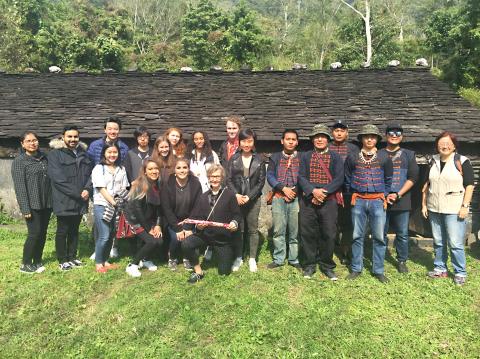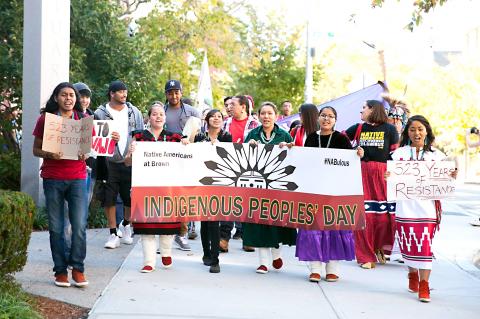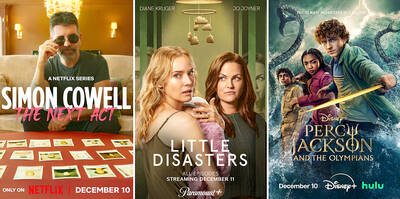Sierra Edd was surprised to hear a museum guide in Taiwan mention that Aborigines and other minorities around the world are vanishing — including Native Americans in the US.
“That was very striking for [the guide] to get that impression when we were in the same room,” she says, noting that the group of 12 students she was with included, in addition to herself, three other Native Americans.
“That message actually gets conveyed in a lot of different ways, even without a label or a guide to say that,” Edd’s professor, Caroline Frank, says.

Photo courtesy of Caroline Frank
The group from Brown University recently spent a week in Taiwan as part of a three-week winter break course, Decolonizing Museums: Collecting Indigenous Culture in North America and Taiwan.
From the National Taiwan University Museum of Anthropology in Taipei to the Indigenous Peoples Culture Park in Pingtung, they dissected labels, presentations, language and scrutinized every word the guides said, comparing them with Native American exhibits in the US. The students also visited a Paiwan village and spent a day with its residents.
The course is part of a three-year partnership between Taiwan’s Ministry of Education and Brown University that aims to promote awareness of Taiwan among American college students. Although Frank is an American Studies professor, she is interested in transpacific relations and exchanges as well as the power imbalances between different groups of people.

Photo courtesy of Sierra Edd
“It wasn’t obvious why in American Studies we would be teaching about Taiwan,” Frank says. “But when you look at the issues [of what it means to be indigenous], it becomes very logical that there are a lot of common experiences with a similar paradigm of colonialism that was going on.”
EACH OBJECT HAS A STORY
While the often underprivileged Aboriginal communities have much to worry about other than their objects in the museums, Edd says it is an important part as the representation of indigenous peoples is a “good first step toward the long process of decolonization.”
Edd, for example, had the wrong idea about the Paiwan people’s hierarchical society based on a museum display until she had dinner with a Paiwan woman who explained the system in her own terms. Frank says another student mentioned that he was getting sick of seeing the same object used to represent each Aboriginal group.
“Often in displays, the object is a stand in for the entire person,” she says. “The message there is that these objects are the people. They are frozen in time and they’re not allowed to change. It’s a tradition. It’s not a presence ... In fact, I’m not sure if we want to be representing people at all in museums as they are political spaces.”
While Frank says the ideal is to collaborate with indigenous communities or have them run their own museums, it is difficult for these institutions to tear everything down and start over. One method to give more context is the object biography, where one traces the lifespan of the object, from the cultural context under which it was made to how it ended up in the museum.
Frank says she finds it interesting that while the colonizers tried to wipe out indigenous culture, they were collecting their objects at the same time. In Taiwan, there’s an additional dynamic as the Han Chinese colonizers were in turn colonized by the Japanese.
Many objects in anthropology museums were appropriated by questionable means, she says.
“There are storerooms and storerooms filled with these objects in both the US and Taiwan” Frank says.
And too often the exhibits obscure the long history of oppression of Aboriginal peoples by different colonizers — be it the Japanese and Han Chinese in Taiwan or the British, Spanish and French in the US.
“What we really need to do is openly address the trauma, the genocide, all the violences of colonialism,” Frank says. “If you don’t do that in presenting these objects, you’re doing something fake. You’re miseducating people.”
GLOBAL INDIGENOUS VOICES
On the last day, Edd and several other students chose to spend the only free time they had visiting with the Aboriginal land rights protesters camped out near the Presidential Palace. In addition to learning about museums and Aboriginal representations, Edd saw the trip as a chance to interact with indigenous people from another country. An activist herself, Edd hopes to earn a PhD in American or Indigenous Studies and either teach or build indigenous-focused curriculums using indigenous methodologies.
“It’s great to learn global histories from indigenous people, so we can start conversations with each other about indigenous rights and activism and how that fits into the global aspect,” she says. “A lot of world problems are linked to colonialism and global empires, and for future generations it will still be pertinent to talk about. It’s important to forge these relations now.”
She adds that there has been a resurgence in the awareness of global indigenous identity, especially with the advent of social media. For example, in Taiwan, there has been a growing focus on exchanges between Aboriginals and other Austronesian peoples around the world.
“It’s empowering for indigenous people who have suffered so much in their individual countries to realize this is not a problem they are experiencing alone,” Frank says. “Global [indigenous awareness] is an important movement right now, as some of the issues may be more apparent to people when they’re in another country.”
While talking to residents at the Paiwan village of Kaviyangan in Pingtung County, Edd found many similarities with Native American reservations in the US, especially with young people leaving and not returning due to lack of economic opportunities.
“That takes us to the discussion of assimilation and how you can resist oppression … while being away from home,” she says. “We were brainstorming and bouncing ideas off each other, what we’ve seen work and what hasn’t worked. Just being in the moment and talking to them was very amazing.”

As I finally slid into the warm embrace of the hot, clifftop pool, it was a serene moment of reflection. The sound of the river reflected off the cave walls, the white of our camping lights reflected off the dark, shimmering surface of the water, and I reflected on how fortunate I was to be here. After all, the beautiful walk through narrow canyons that had brought us here had been inaccessible for five years — and will be again soon. The day had started at the Huisun Forest Area (惠蓀林場), at the end of Nantou County Route 80, north and east

Specialty sandwiches loaded with the contents of an entire charcuterie board, overflowing with sauces, creams and all manner of creative add-ons, is perhaps one of the biggest global food trends of this year. From London to New York, lines form down the block for mortadella, burrata, pistachio and more stuffed between slices of fresh sourdough, rye or focaccia. To try the trend in Taipei, Munchies Mafia is for sure the spot — could this be the best sandwich in town? Carlos from Spain and Sergio from Mexico opened this spot just seven months ago. The two met working in the

Exceptions to the rule are sometimes revealing. For a brief few years, there was an emerging ideological split between the Democratic Progressive Party (DPP) and Chinese Nationalist Party (KMT) that appeared to be pushing the DPP in a direction that would be considered more liberal, and the KMT more conservative. In the previous column, “The KMT-DPP’s bureaucrat-led developmental state” (Dec. 11, page 12), we examined how Taiwan’s democratic system developed, and how both the two main parties largely accepted a similar consensus on how Taiwan should be run domestically and did not split along the left-right lines more familiar in

A six-episode, behind-the-scenes Disney+ docuseries about Taylor Swift’s Eras Tour and Rian Johnson’s third Knives Out movie, Wake Up Dead Man, are some of the new television, films, music and games headed to a device near you. Also among the streaming offerings worth your time this week: Chip and Joanna Gaines take on a big job revamping a small home in the mountains of Colorado, video gamers can skateboard through hell in Sam Eng’s Skate Story and Rob Reiner gets the band back together for Spinal Tap II: The End Continues. MOVIES ■ Rian Johnson’s third Knives Out movie, Wake Up Dead Man